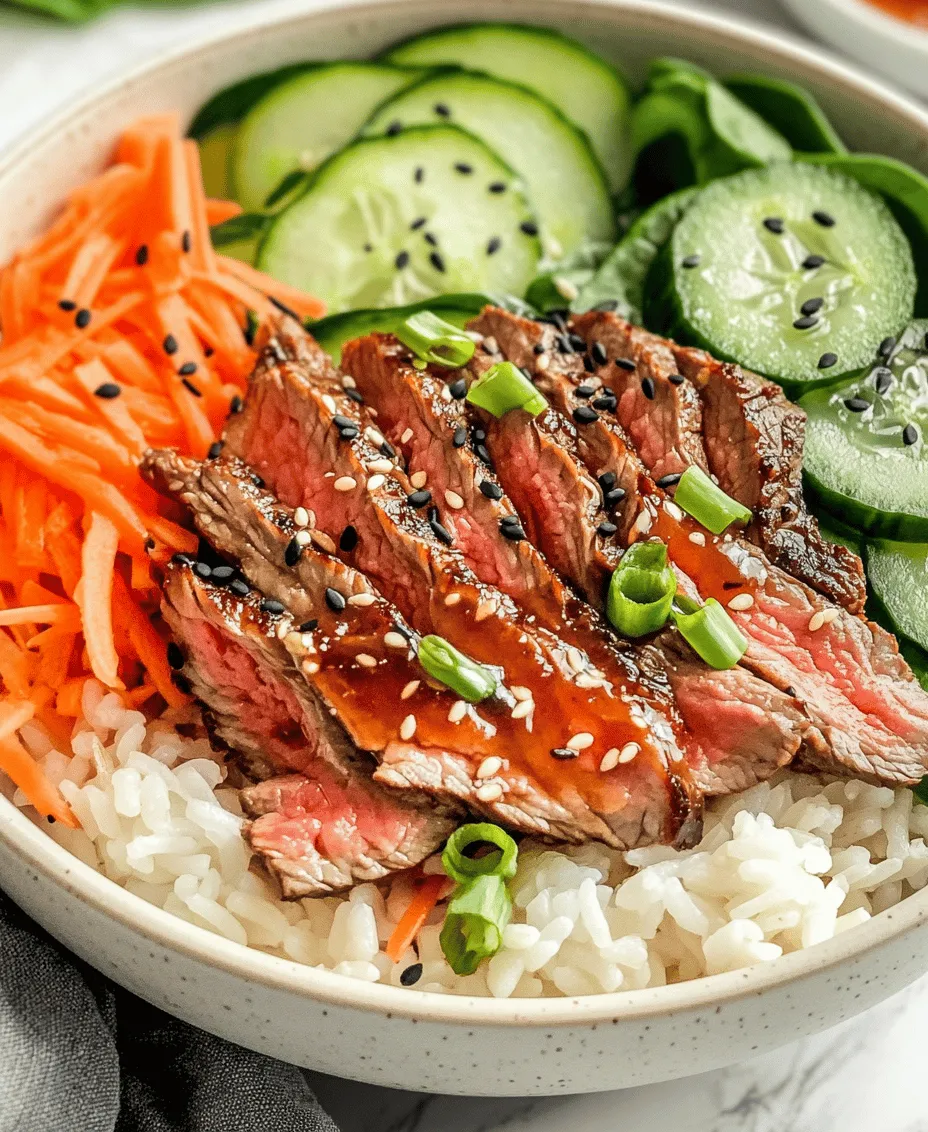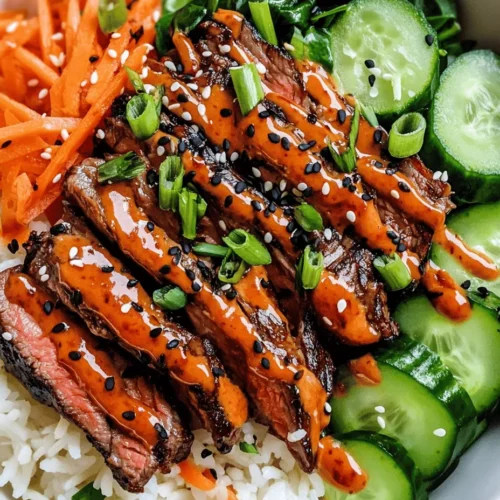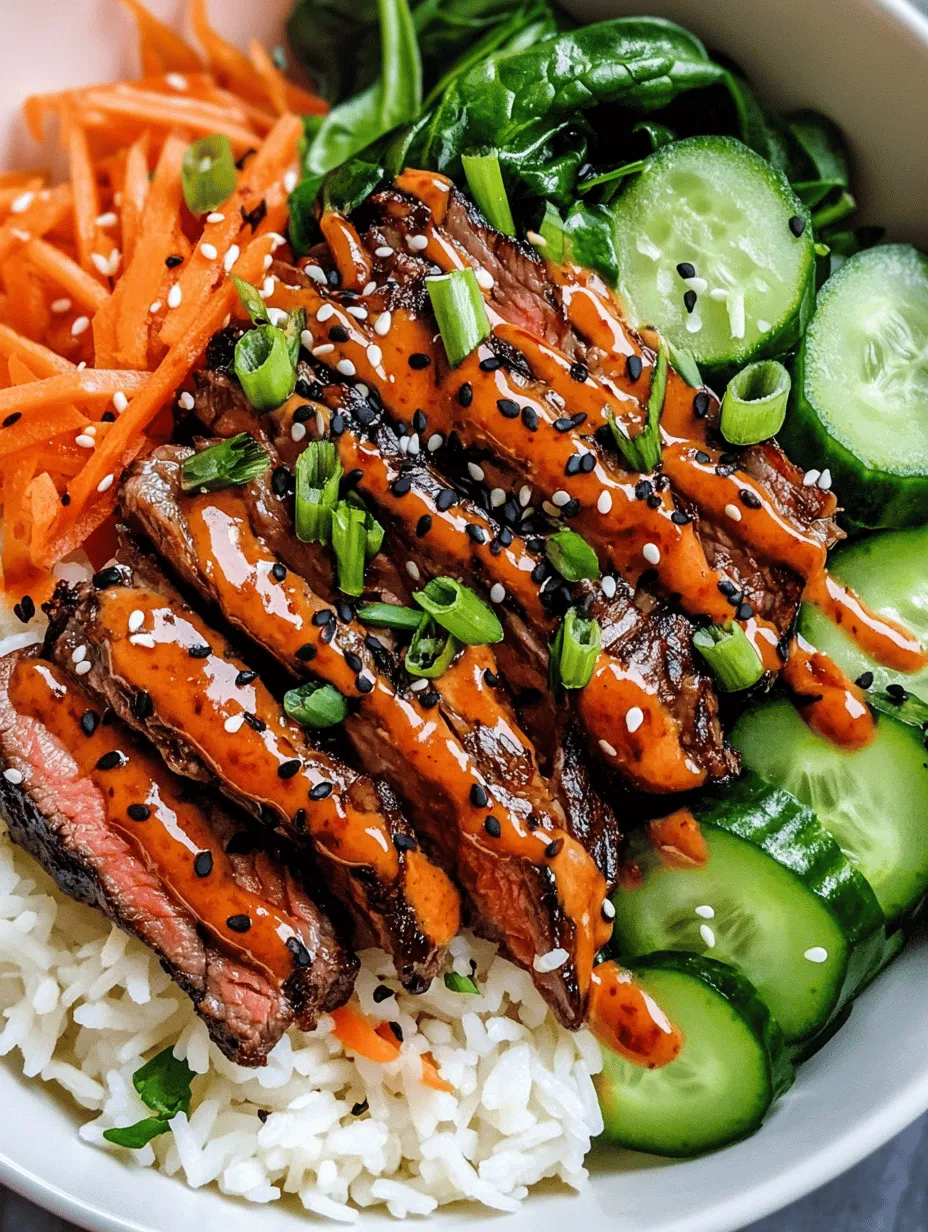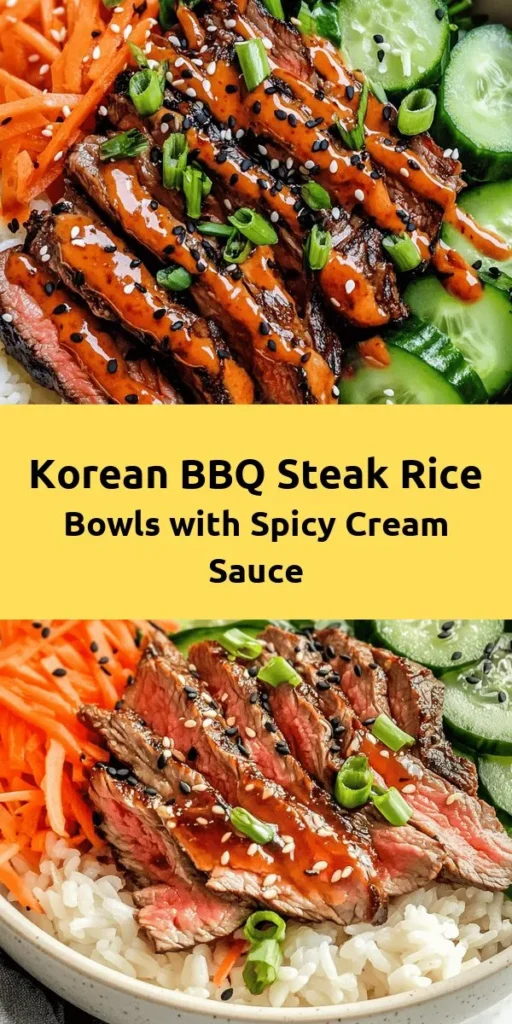Korean BBQ Steak Rice Bowls with Spicy Cream Sauce is a culinary experience that brings together the vibrant flavors of Korean cuisine and the comforting familiarity of a rice bowl. This dish features marinated flank steak that is grilled to perfection and served over a bed of fluffy jasmine rice, accompanied by an array of fresh vegetables. The pièce de résistance is the rich and spicy cream sauce that ties all the elements together, resulting in a meal that is not only visually appealing but also packed with flavor. Whether you’re looking for a quick weeknight dinner or planning a gathering with friends and family, this recipe is sure to impress and satisfy.
In this article, we will delve into the ingredients and preparation steps needed to create this mouthwatering dish at home. Along the way, we’ll also explore the cultural significance of Korean BBQ and the health benefits of its components, making this a comprehensive guide for anyone looking to elevate their culinary skills.
Understanding Korean BBQ
The Rich Tradition of Korean Barbecue
Korean BBQ is more than just a meal; it is a social event that has become an integral part of Korean culture. Traditionally, this style of cooking involves grilling marinated meats at the table, allowing diners to enjoy the interactive experience of cooking their food right before their eyes. The communal aspect of Korean BBQ fosters a sense of togetherness and celebration, making it a popular choice for family gatherings and special occasions.
The origins of Korean BBQ can be traced back to the Goryeo Dynasty (918–1392), where grilled meat was enjoyed during royal feasts. Over the centuries, this practice evolved, and today, it encompasses a variety of meats, marinades, and side dishes known as banchan. The diverse flavors and textures found in Korean BBQ reflect the country’s rich agricultural resources and culinary traditions.
Exploring the Cultural Heritage of Korean BBQ
Korean BBQ is characterized by its bold flavors and unique cooking techniques. The use of marinades made from ingredients such as soy sauce, sesame oil, garlic, and ginger not only tenderizes the meat but also infuses it with a depth of flavor that is quintessentially Korean. This emphasis on marinated meats is a testament to the importance of flavor in Korean cooking, as well as the influence of neighboring countries like China and Japan.
In addition to the grilling process, the accompanying side dishes play a crucial role in the Korean BBQ experience. These banchan, which can include pickled vegetables, kimchi, and various salads, add layers of flavor and texture to the meal, enhancing the overall dining experience.
The Role of Marinades in Korean Cuisine
Marinades are a cornerstone of Korean cuisine, and their significance cannot be overstated. They serve not only to flavor the meat but also to tenderize it, allowing for a more enjoyable eating experience. Common marinade ingredients include:
– Soy Sauce: Provides a savory umami flavor that enhances the meat’s natural taste.
– Sesame Oil: Adds a rich, nutty aroma that complements the other flavors.
– Garlic and Ginger: Contributes a pungent and aromatic quality that elevates the dish.
– Sugar: Balances out the saltiness and adds a touch of sweetness.
In the case of our Korean BBQ Steak Rice Bowls, the marinade for the flank steak is designed to infuse the meat with these classic flavors, creating a deliciously savory and aromatic centerpiece for the dish.
Ingredients Breakdown
Essential Components of the Korean BBQ Steak
To create the perfectly marinated flank steak for your rice bowl, you’ll need the following ingredients:
– Flank Steak: This cut of meat is ideal for marinating and grilling due to its rich flavor and tenderness when cooked properly. It absorbs marinades well and is often used in Korean BBQ dishes.
– Soy Sauce: The base of your marinade, providing essential umami flavor.
– Brown Sugar: To add sweetness and help with caramelization during grilling.
– Sesame Oil: A key ingredient that imparts a distinct aroma and flavor.
– Garlic and Ginger: Freshly minced for maximum flavor impact.
– Pepper: For a bit of heat and spice.
Analyzing the Flavor Profile of Each Ingredient
When combined, these ingredients create a harmonious flavor profile that is both savory and slightly sweet, with aromatic undertones from the garlic and ginger. The soy sauce adds depth, while the sesame oil provides a delightful nuttiness that characterizes many Korean dishes.
Fresh Vegetables and Their Nutritional Benefits
To complement the grilled flank steak and add freshness to the dish, a variety of vegetables are included. Here are some common options:
– Cucumber: Crisp and refreshing, cucumbers provide hydration and crunch.
– Carrots: Sweet and vibrant, they add color and a good source of beta carotene.
– Green Onions: A classic garnish in Korean cuisine, they add a mild onion flavor and a pop of color.
– Spinach or Bok Choy: Leafy greens add nutrients and a touch of earthiness.
Incorporating these vegetables not only enhances the visual appeal of the dish but also contributes essential vitamins and minerals, making your meal more nutritious.
The Importance of the Spicy Cream Sauce
The crowning glory of this Korean BBQ Steak Rice Bowl is the spicy cream sauce. This sauce is rich, creamy, and, as the name suggests, adds a spicy kick that elevates the entire dish. Here’s what you’ll need to create it:
– Mayonnaise: The base of the sauce, providing creaminess and richness.
– Sriracha: For heat and a hint of sweetness.
– Lime Juice: Adds acidity to balance the richness of the mayonnaise.
– Garlic Powder: For an extra layer of flavor.
This spicy cream sauce not only enhances the taste of the grilled steak but also provides a delightful contrast to the fluffy rice and fresh vegetables.
Preparation Steps
Marinating the Steak for Optimal Flavor
The first step in preparing your Korean BBQ Steak Rice Bowl is to marinate the flank steak. Here’s how to do it:
1. Prepare the Marinade: In a mixing bowl, combine soy sauce, brown sugar, sesame oil, minced garlic, minced ginger, and black pepper. Whisk until the sugar is fully dissolved.
2. Marinate the Steak: Place the flank steak in a resealable plastic bag or a shallow dish. Pour the marinade over the steak, ensuring it is well-coated. Seal the bag or cover the dish and refrigerate for at least 30 minutes, though longer (up to overnight) will yield even more flavor.
3. Remove from Marinade: Once marinated, remove the steak from the marinade and let it sit at room temperature for about 15 minutes before grilling. This helps the meat cook more evenly.
The Science Behind Marination
Marination is an essential technique in cooking that not only infuses flavor but also enhances the texture of the meat. The acidic components in the marinade, such as soy sauce and any citrus juice, break down the proteins in the meat, making it more tender. Additionally, the sugars in the marinade aid in caramelization during cooking, resulting in a beautifully browned crust that enhances the overall flavor.
Crafting the Perfect Spicy Cream Sauce
While the steak is marinating, you can prepare the spicy cream sauce:
1. Combine Ingredients: In a small bowl, mix together mayonnaise, Sriracha, lime juice, and garlic powder. Adjust the amount of Sriracha based on your spice tolerance.
2. Taste and Adjust: Give the sauce a taste and adjust the seasoning as desired. You may want it spicier or tangier, depending on your preference.
This sauce can be made ahead of time and stored in the refrigerator until you’re ready to serve, allowing the flavors to meld together.
Grilling Techniques for Steak Perfection
Grilling is a key component of Korean BBQ, and mastering the technique will ensure your steak turns out perfectly:
1. Preheat the Grill: Ensure your grill is preheated to high heat. This allows for a nice sear, locking in the juices of the steak.
2. Grill the Steak: Place the marinated flank steak on the grill. Cook for about 4-5 minutes on each side for medium-rare, depending on the thickness of the steak. Use a meat thermometer to check for doneness, aiming for an internal temperature of 130°F for medium-rare.
3. Rest the Meat: Once grilled to your liking, remove the steak from the grill and let it rest for about 10 minutes. This step is crucial as it allows the juices to redistribute, resulting in a more tender and flavorful steak.
Assembling the Rice Bowls for Visual Appeal
Now that your steak is grilled and resting, it’s time to assemble your rice bowls:
1. Cook the Rice: Prepare jasmine rice according to package instructions. Fluff with a fork once done.
2. Slice the Steak: After resting, slice the flank steak against the grain into thin strips. This will ensure maximum tenderness in each bite.
3. Layer the Ingredients: In a serving bowl, start with a base of jasmine rice, then layer on the sliced steak. Add your choice of fresh vegetables, such as cucumber, carrots, and green onions, for a colorful presentation.
4. Drizzle with Sauce: Finally, drizzle the spicy cream sauce generously over the top, adding a final touch of flavor and visual appeal.
With these steps complete, your Korean BBQ Steak Rice Bowls with Spicy Cream Sauce are ready to serve. Enjoy the vibrant flavors and the delightful experience of Korean BBQ right in the comfort of your home.

Grilling vs. Pan-Searing: Which Method to Choose?
When it comes to cooking steak for your Korean BBQ Rice Bowls, the method you choose can greatly influence the flavor and texture of the meat. Both grilling and pan-searing offer unique benefits and can produce delicious results.
Grilling is a popular choice for its ability to impart a smoky flavor that is synonymous with BBQ. If you have access to an outdoor grill, this method allows for high heat and direct cooking, creating a delectable char on the steak. The heat from the grill sears the meat quickly, locking in juices and resulting in a tender interior.
Pan-searing, on the other hand, is a great option if you prefer cooking indoors or don’t have a grill. Using a heavy skillet, preferably cast iron, you can achieve a similar sear and crust. Pan-searing allows for more control over the cooking temperature and time, making it easier to achieve your desired doneness. Additionally, you can easily make a sauce in the same pan after cooking, utilizing the fond left behind for extra flavor.
Ultimately, the choice between grilling and pan-searing comes down to personal preference and available equipment. Whichever method you choose, be sure to monitor the cooking closely to avoid overcooking the steak.
Understanding Doneness Levels for Steak
Achieving the perfect doneness is crucial for your Korean BBQ Steak. Here’s a quick guide to the various levels of doneness:
– Rare (125°F): Bright red center, soft texture.
– Medium Rare (135°F): Warm red center, firm but still tender.
– Medium (145°F): Pink center, slightly firmer.
– Medium Well (150°F): A hint of pink, drier texture.
– Well Done (160°F and above): Fully cooked, brown throughout, less juicy.
Using a meat thermometer can help ensure you reach the desired doneness. For the most flavorful results, medium rare to medium is recommended, as this retains the juices and enhances the overall taste of the dish.
Resting Your Steak: Why It Matters
Resting your steak after cooking is a vital step that many cooks overlook. Once removed from the heat, allow your steak to rest for about 5-10 minutes before slicing. This rest period enables the juices to redistribute throughout the meat, ensuring that each bite is tender and flavorful.
If you cut into the steak too soon, those precious juices will run out, leaving you with a drier piece of meat. A rested steak will not only taste better but will also have a more appealing texture, making it a worthy addition to your rice bowls.
Health Benefits of Ingredients
Creating a delicious meal is not just about flavor; it’s also about nutrition. Here’s a closer look at the health benefits of the key ingredients in your Korean BBQ Steak Rice Bowls.
Flank Steak: A Lean Protein Choice
Flank steak is an excellent source of lean protein, making it a nutritious option for your rice bowls. It contains essential amino acids, which are vital for muscle repair and growth. Additionally, flank steak is lower in fat compared to other cuts, making it a heart-healthy choice. It also provides important vitamins and minerals, including iron, zinc, and B vitamins, which support energy production and overall health.
The Nutritional Value of Jasmine Rice
Jasmine rice, a staple in many Asian cuisines, is not only aromatic and flavorful but also offers nutritional benefits. It is a good source of carbohydrates, providing the energy needed for daily activities. Jasmine rice is also gluten-free, making it suitable for those with gluten sensitivity. While it is less fibrous than brown rice, it still contains small amounts of essential nutrients like manganese and selenium, which play a role in metabolism and antioxidant protection.
Benefits of Fresh Vegetables in Your Diet
Adding fresh vegetables to your rice bowls not only enhances flavor and texture but also boosts nutritional value. Vegetables such as bell peppers, carrots, and scallions are rich in vitamins, minerals, and antioxidants. They provide fiber, which aids in digestion and helps maintain a healthy weight. The variety of colors in vegetables also indicates a range of nutrients, making it important to include a colorful assortment in your meals.
The Role of Spices in Enhancing Health
The spices used in the marinade and the spicy cream sauce are more than just flavor enhancers; they also offer various health benefits. Ingredients like garlic and ginger have anti-inflammatory properties and can help support the immune system. Additionally, red pepper flakes or gochugaru not only add heat but also contain capsaicin, which has been linked to improved metabolism and pain relief.
Serving Suggestions
To elevate your Korean BBQ Steak Rice Bowls, consider these serving suggestions that complement the dish beautifully.
Pairing Side Dishes with Korean BBQ Steak Rice Bowls
Side dishes can enhance the overall experience of your meal. Traditional Korean sides, known as banchan, can include:
– Kimchi: Fermented vegetables that provide probiotics and a spicy kick.
– Pickled Radishes: Crunchy and tangy, they balance the richness of the steak.
– Stir-Fried Vegetables: Quick sautéed greens or mushrooms add color and nutrients.
These sides not only add variety to your meal but also contribute to a well-rounded dining experience.
Beverage Recommendations to Complement the Dish
Pairing the right beverage can elevate your meal. Here are some suggestions:
– Soju: A popular Korean spirit that complements savory dishes.
– Korean Beer: Light lagers or wheat beers can refresh the palate.
– Iced Green Tea: A non-alcoholic option that provides a clean taste and complements the flavors of the dish.
Exploring Variations: Customizing Your Rice Bowl
One of the great things about rice bowls is their versatility. Feel free to customize your Korean BBQ Steak Rice Bowls by experimenting with different ingredients. Here are a few ideas:
– Alternate Proteins: Swap flank steak for chicken, pork, or tofu for a vegetarian option.
– Different Rice Varieties: Use brown rice or quinoa for added fiber and nutrition.
– Creative Toppings: Add a fried egg, avocado slices, or sesame seeds for added richness and texture.
These variations allow you to tailor the dish to your taste preferences and dietary needs.
Storing and Reheating Leftovers
If you find yourself with leftovers, proper storage and reheating are essential for preserving flavor and quality.
Best Practices for Storing Cooked Steak and Rice
To store your cooked steak and rice, allow them to cool to room temperature before placing them in airtight containers. Keep the steak and rice separate to maintain their textures. Store in the refrigerator for up to 3-4 days or freeze for longer storage. When freezing, consider vacuum sealing to prevent freezer burn.
How to Reheat for Maximum Flavor Retention
Reheating should be done carefully to avoid drying out the steak:
– For the Steak: Reheat in a skillet over low heat, adding a splash of beef broth or water to maintain moisture. Cover the skillet to help steam the meat.
– For the Rice: Microwave with a damp paper towel on top to create steam, or reheat in a pot with a splash of water, stirring occasionally to prevent sticking.
Creative Ways to Use Leftover Ingredients
Leftover steak and rice can be transformed into other meals. Consider:
– Steak Tacos: Use leftover steak in soft tortillas with fresh veggies and salsa.
– Fried Rice: Stir-fry leftover rice with vegetables and soy sauce for a quick meal.
– Steak Salad: Top a fresh salad with sliced steak and your favorite dressing for a nutritious lunch.
Conclusion
Korean BBQ Steak Rice Bowls with Spicy Cream Sauce is not only a satisfying meal but also a reflection of the vibrant flavors and traditions of Korean cuisine. By mastering the marination technique, understanding cooking methods, and appreciating the nutritional benefits of each ingredient, you can create a dish that is both delicious and health-conscious. This recipe provides a delightful culinary experience while opening the door to exploring the rich tapestry of Korean food culture.
Whether enjoyed at home or shared with loved ones, this dish is a perfect way to celebrate the joy of cooking and dining together. The combination of tender steak, flavorful rice, and fresh vegetables, all enhanced by a spicy cream sauce, creates a memorable meal that is sure to impress. So gather your ingredients, fire up your grill or skillet, and embark on this culinary adventure that embodies the essence of Korean BBQ.



